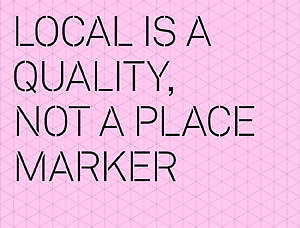
How might we design new forms of localism (in a globalised world)?
What kind of local qualities might we design in the way we live, produce and consume? What might we (re-) design in our living environments to enhance local qualities and local experiences? What might it mean to design for the “local” in different domains, such as food, education, community, and production? How can we bring out the “local” character of our neighborhoods, whilst acknowledging that we also are connected to all kinds of global developments?
Background local.
Whilst the world is more globalised than ever before, and we’re in the middle of a global media revolution, we see a resurgence of localism, and a longing for local qualities. But different from the past: now every place on the globe is connected 24/7, the global and local are no longer opposites. In the sustainist era we're both locally-rooted and globally-connected.
Especially in the urban context, the local takes on new forms, because we want to be part of local communities, and have a local identity, whilst at the same time we wish to part of a global community. We have local homes but at the same time see the planet as our home. For the first time in human history many people can choose if and when and in what sense they wish to be local, and when they want to be global. The reality is that we now can be both.
In the sustainist era, the "local" will take on new meanings. The “local” qualities and the new forms of locality that are now emerging have everything to do with globalization and global connectivity. The future will bring a kind of localism that links the local to the global in novel ways.
Local qualities connect with global aspirations and global concerns, for example in social and environmental awareness. The new forms of localism that that we design create a kind of “glocal” realities.
The new localism is not provincial, it’s a kind of “cosmopolitan local” as some have called it. In the culture of sustainism becomes a valued quality, not a geographical marker.
Farmers’ markets and Etsy as exemplars.
The “local” is re-valued. Interest in the local is rapidly rising. A striking example is the growth in local farmers’ markets. In the U.S. there are currently over 7000 local farmers’ markets, and their number is growing by 10 to 20 each week.
The way local farmers markets operate may become the conceptual model for the future. It values direct contact between local producer and consumer, gives us direct knowledge of what we buy. (And in the case of food it is often healthier and tastes better too). The farmers’ market model meaningful because it is more personal that mass markets and adds “feel good” value, and enhances local community.
A similar mentality can be felt, for example, at Etsy, the online “eBay” for handmade, often crafts-based products. Here is a global marketplace for small-scale production, locally organized with 500,000 makers worldwide, and some 9 million buyers globally. Here is a typical “glocal” form, in which local and global features are essential in its design.